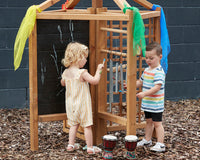There is a vast amount of different terms linked to the brass instrument family. This can become very confusing at times, especially if you are new to the instrument. In this article, we have compiled the most common brass instrument terms to guide you through the very basics of the brass family.
- Bell – features in all brass instruments, vital for good sound projection and bright tone. Different sizes and materials will influence the characteristics of the instrument. For example, rose brass will give the instrument a warmer tone, whereas, yellow brass will help to produce a brighter tone.
- Bore is the hollow space running through the centre of brass instrument’s tubing. Bores can be of different sizes and shapes.
- Embouchure is used to describe the shape and position of the musician’s mouth whilst playing their instrument. The correct embouchure for brass instruments requires facial muscle control and the lips to be placed in central position on the mouthpiece to produce a good sound.
- Finish – there are two different types of finish including silver or lacquer. Usually, a lacquer finish will produce a warmer tone and the silver finish will create a brighter sounding tone.
- Finger Ring & Thumb Hook is a small metal hook for your thumb or a ring for your little finger. These are used to ensure that your hand position is accurate whilst helping you to balance the instrument comfortably.
- Hand Hammered Bell – usually found in more expensive instruments, predominantly on trumpets, French horns and cornets. The bell is hammered by hand to create the accurate symmetrical shape.
- Lead Pipe and Receiver – the receiver is the end of the first part of tubing (known as the lead pipe) into which the mouthpiece is fitted.
- Monel Valves – valves made of monel, a hard wearing metal alloy. Normally used to make the valves for intermediate and professional instruments. Monel is more robust and lasts longer than the metal used in standard valves.
- Mutes – these are inserted into the bell of a brass instrument to alter the sound. A simple practice mute will just muffle the sound to allow the player to practice silently. There are also many types of mutes used in performances that create a unique effect which will alter the sound and tone of your instrument.
- Piston Valves - used in majority of valved brass instruments, excluding French horns. At the tops of the valves you have the buttons which are pressed by the musician’s fingers. Inside the valves are the holes which let the air pass and when the buttons are pushed down they alter the pitch of the instrument.
- Reversed Lead – some trumpets will have a reverse lead pipe where one end of the pipe is longer than the other and fits around the outside of the body tubing. This creates a slightly different air flow and some trumpetists say this helps to produce a smoother and brighter sound.
- Rotary Valves – common in French Horns, rotary valves turn in a clockwise direction as oppose to being pressed down like you would do with piston valves.
- Slides – features in all brass instruments, mostly used alongside valves to alter tuning, however, when playing a trombone, slide is moved in and out.
- Trigger – mechanical lever, that allows the player to temporarily adjust tuning of certain notes by lengthening the main tuning slide or valve slide. Triggers are usually found on advanced trumpets and cornets and, sometimes, euphoniums and do not feature on beginners’ instruments as triggers are only useful for an experienced player.
- Water keys – usually situated on the lowest parts of the instrument and are spring loaded with a rubber or cork bung. These can be opened to release excess moisture from the inside of the instrument after or during long playing sessions.




















